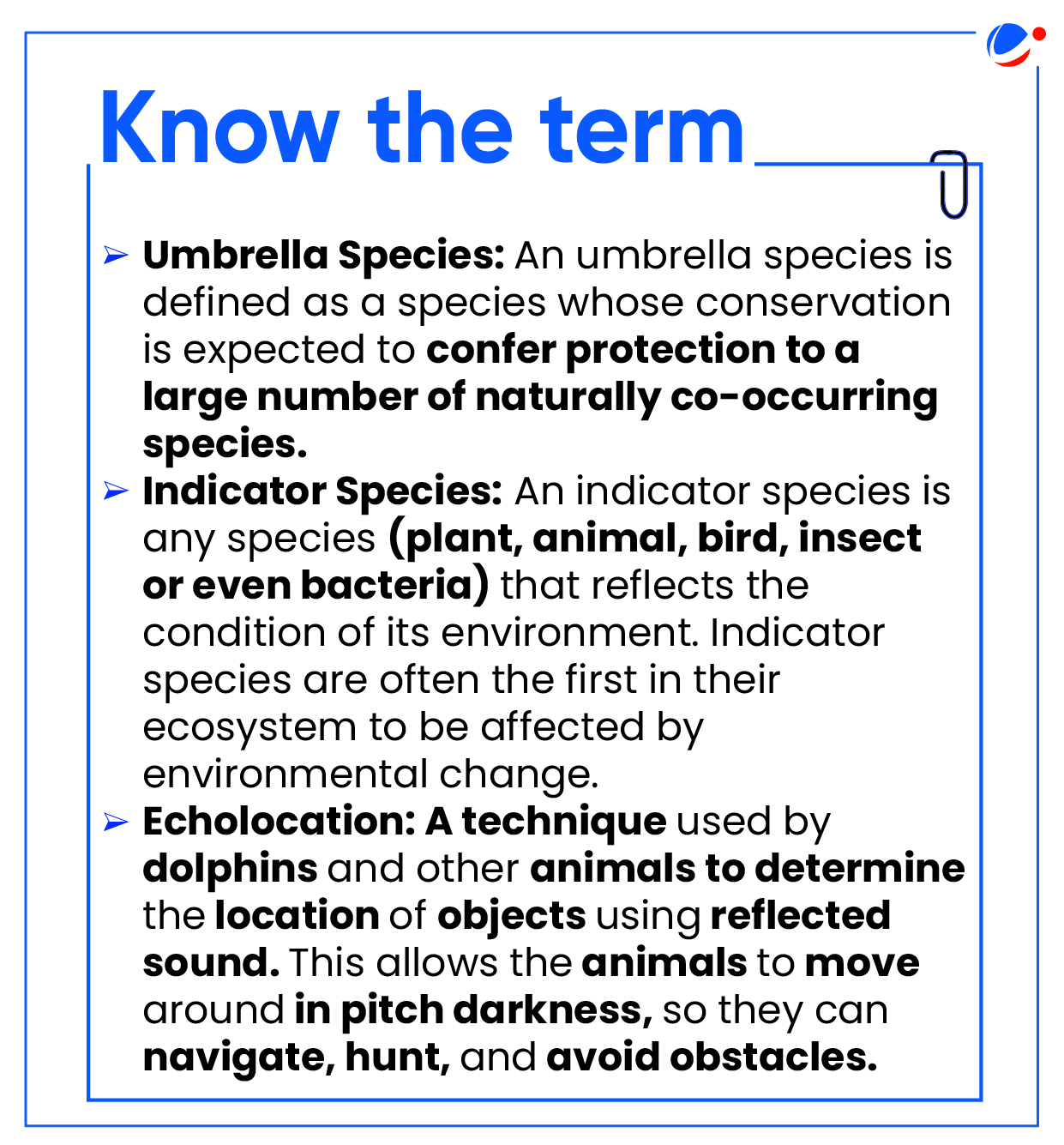
Why in the News?
The first-ever comprehensive survey of river dolphins has revealed a population estimate of 6,327 dolphins mainly in the Ganga, Brahmaputra and Indus River basins.
More on news
- Conducted by: Survey was conducted by Wildlife Institute of India under Project Dolphin 2020.
- Name of the report: Survey findings are published in the Report titled 'Population Status of River Dolphins in India- 2024'.
Key findings of 'Population Status of River Dolphins in India – 2024' Report
- Decline overtime: Number of Ganges River dolphins were estimated to be around 4,000-5,000 by the end of the 20th century, but dropped to about 1,800 individuals.
- Population: Overall river dolphin population in India is 6327 including Gangetic River dolphins (6324) and Indus River Dolphins (only 3).

- Uttar Pradesh has the highest dolphin population at followed by Bihar, West Bengal, Assam Jharkhand, Madhya Pradesh and Rajasthan. Punjab recorded the lowest, with three dolphins.
- Indus River Dolphin: Indus River Dolphin in India, currently observed in the Beas River, is worryingly low in numbers and demands urgent conservation attention.
- Umbrella species: The report stated that the dolphins act as an umbrella species and their conservation has direct impacts on their habitat and biodiversity.
Facts about Gangetic River dolphins
- Location: The majority of Ganges River dolphins are found in the Ganges, Brahmaputra, Meghna and Sangu Karnaphuli River systems in India and Bangladesh, with fewer in tributaries in Nepal.
- India is home to 90% of the world's Ganges river dolphins.
- National aquatic Animal of India: They have been designated as the National aquatic Animal of India.
- Local name: Known as susu, which refers to the noise the dolphin is said to make when it breathes,
- Apex predator: Top most predator interconnected river system in three countries and called the "tiger of the ganges".
- Protection: CITES: Appendix I, Wildlife Protection Act: Schedule I, IUCN: Endangered.
- Indicator species: The Gangetic dolphin is an indicator species, whose status provides information on the overall condition of the ecosystem and of other species in that ecosystem.
- Socialization: Ganges river dolphins are most frequently found alone, but they gather in small groups, sometimes at the confluence of tributaries.
- Physical details:
- It is blind and finds its way and prey in river waters through echolocation.
- Color: Ganges river dolphins are usually a grey or light brown colour, but may also have a pinkish tone to the belly.
Key facts about Indus River dolphin (IUCN: Endangered)
|
Threats to Gangetic river dolphins
- Fisheries-related mortality and unsustainable fishing: Bycatch is the number one cause of river dolphin mortality, which together with intentional killing of river dolphins for fish bait and meat.
- Man-made water infrastructure: hydropower dams, irrigation barrages and embankments all affect habitat connectivity, isolates them into smaller subpopulations with low genetic diversity.
- For example, The Farakka Barrage spans the entire width of the Ganga River affecting movement.
- Water quality: mining, agriculture, and industrial activities can all degrade water quality.
- Around 2 billion liters of untreated human waste from five separate states enter the Ganges every day.
- Human Disturbance: Increased boat traffic, dredging activities, and noise pollution from human activities disrupt dolphin behavior and habitat quality.
- Climate Change: The effects of climate change are driving more saltwater into their river habitats making it unsuitable for dolphins.
- For example, Freshwater dolphins were disappearing from the Sundarbans delta, due to a reduction in freshwater flow and increased salinity.
Indian Initiatives to protect River Dolphins
- Comprehensive Action Plan (2022-2047): Ministry of Environment, Forest and Climate Change has prepared a Plan which focuses on river dolphin protection, habitat improvement etc.
- Development of Wildlife habitats scheme; Gangetic river dolphin have been included as one of the 22 critically endangered species for providing financial assistance to States'.
- Protected Areas: Important habitats of Gangetic river dolphin along the Ganges River has been notified as Protected Areas, such as Vikramshila Dolphin Sanctuary, Bihar.
- Chambal River Conservation Zone: Government has designated it as a Dolphin Conservation Zone to implement targeted protection efforts.
- A 200 km stretch in Madhya Pradesh, Rajasthan, and Uttar Pradesh has been recommended for targeted protection efforts.
- National Dolphin Day: October 5th is celebrated as "National Dolphin Day" to raise awareness.
- Guidelines for States: States have been urged to align with International Whaling Commission regulations, appointing Dolphin and Whaling Commissioners for conservation efforts.
- India's first National Dolphin Research Centre (NDRC): It inaugurated in Patna, Bihar for dedicated study of Gangetic dolphins.
- Ganges River Dolphin Tagging: In 2024, India successfully achieved satellite-tagging the first-ever Ganges River Dolphin in Assam under Project Dolphin.
Conclusion
Effective river dolphin conservation requires bridging the information gap through large-scale satellite tagging, engaging communities as "Dolphin Rescue Volunteers," promoting sustainable fishing with electronic pingers, and strengthening international partnerships with Nepal and Bangladesh by initiatives like Global Declaration for River Dolphins.



